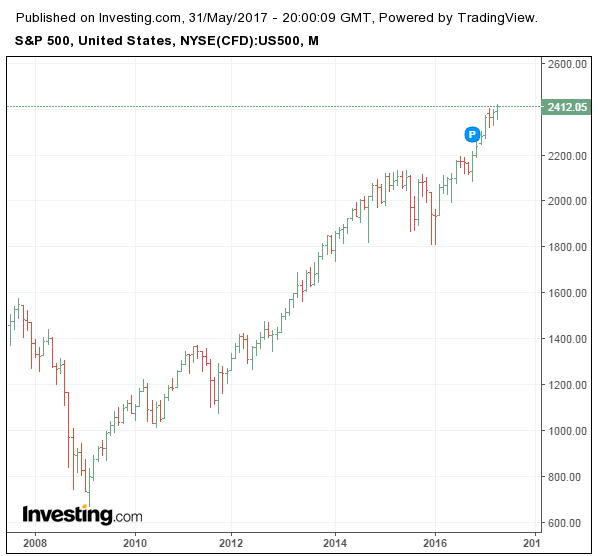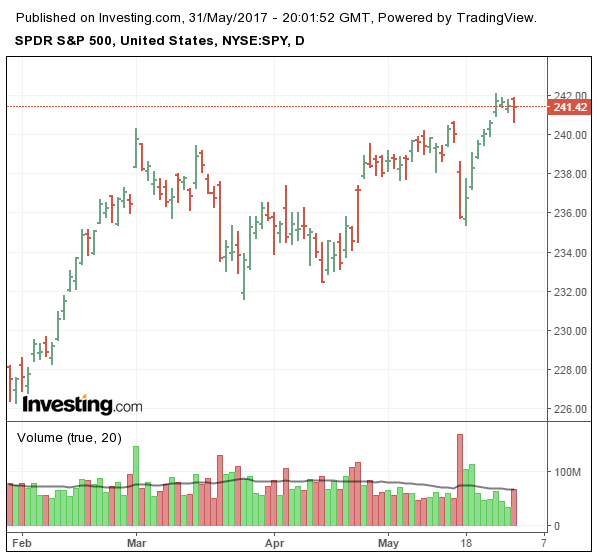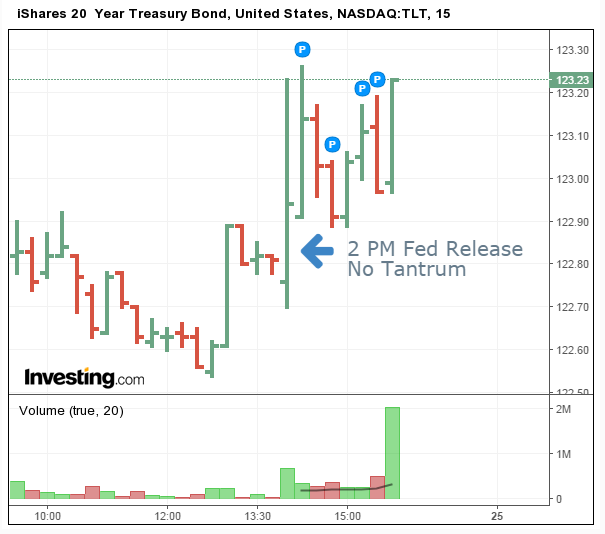by Chaim Siegel of Elazar Advisors, LLC

Let's say something obvious up front: people define the tone and tenor of the markets. If we can decide if people are “all in” then the market is frothy. If we can provide lots of color showing that everybody’s not “all in,” then the market is not so frothy. So let’s try and decide.
Market Already Up?
Just because a market is up does not mean it’s frothy. That just tells you, well, that it’s up. What drives that upward movement are many things, mainly investor expectations for earnings.
Markets being up are really telling you that investors are expecting higher earnings. The market expecting higher earnings is not so far fetched. According to Factset, S&P 500 earnings in Q1 were up 13.6%, which is the best growth we’ve seen since Q3 2011.
Expecting stronger earnings now after the best quarter in almost six years makes sense.
So is the market frothy? We think it's fair to say that earnings showing break-out growth rates is a legitimate reason for higher stock prices. That’s not froth.

Year-to-date the SPDR S&P 500 Fund (NYSE:SPY), the SPX ETF, is up 8.6%. That’s a good year but not a blow-out, not yet. The SPY has been known to have 10, 20 and 30% swings in a year. So again, 8.6% is good, but far from frothy.
Think about it. The world is telling you the market is frothy yet the main index is only up 8%. What that does tell us is there are still plenty of skeptics that need to jump in at some point.
So Everybody’s In?
Sentiment is a great way to know if everybody is in. There are two ways to use sentiment. One is to simply look to see if it’s high or low. For us, that never tells the real story.
The way we like to use sentiment is to compare it versus market action.
For example, if the market goes up, it’s normal that bullishness rises. To us, sentiment up in an up tape doesn’t tell us too much. It’s normal.
Same thing on the downside. If the market goes down and bearishness builds, that’s normal. It also doesn’t tell you so much.
Many traders try to pick tops and bottoms by saying sentiment is too high or low. We think that stat is misleading. How we like to use sentiment is versus market action.
If the market rips higher and people get more bearish, what would you say? We’d say nobody believed the move and they’ll have to give up and jump in with everybody else. That will then push the market even higher.
That’s what we mean by comparing sentiment changes versus action and the market’s directional changes. That’s the case today.
We like to use The American Association Of Individual Investors, AAII, survey.
As of their last read on May 24th, they said Bulls and Neutrals are about at the historical average. Bears are down and are “slightly below” the historical average, now three out of the last four weeks. That’s not such blow away news, is it?
Let’s put it in context though. We ask you, even if the market were to-the-moon, does that sound frothy? We don’t think so.
AAII is showing average bulls, bears and neutrals as a face-ripping market hits new highs regularly. Ho hum, average. Nobody feels forced to jump in. Not yet.
But they will.
What you learn from these stats is that everybody is not in. People are still on the sidelines. A lot of people. The market is therefore not frothy.
The 'Everybody Isn’t In' Icing On The Cake
Kudos to CNBC for a great interview with Professor Jeremy Siegel of Wharton this past Friday.
He clears up the speculation regarding if everybody is in. Dr. Siegel provides painstaking detail as to why rates are still low. While Dr. Siegel has been known to be a perma-bull, he’s also been correct.
He told CNBC that people have not bought into the market yet. People are still shaking from the crash of 2008-09.
Let’s see what he said. We think it’s key when coming to a conclusion regarding if the market is frothy.
“I’ve always been opposed of the idea that it’s a sugar high all created by the central banks. I think the low interest rates are due to very fundamental factors in this economy; low productivity growth, low GDP growth, a lot of risk aversion still out there from the crash of ‘09, an older investor class that is naturally more risk averse, regulatory demands for liquidity. All those things are the primary reason [for low rates]... This low interest rate environment is going to be in place for many years to come, it’s not just a central bank phenomenon.”
Years to come. So we ask you again, is the market frothy?
Incredible Bond Action After Fed Minutes, Explained
Dr. Siegel answered the question we posed last Thursday. Why didn’t bonds tank after the Fed said they were going to initiate the final taper later this year? Because bonds aren’t down due to central banks. Bonds are down because investors are still risk averse.
Here’s the chart of the iShares 20+ Year Treasury Bond ETF (NASDAQ:TLT) after the taper news last Wednesday.

This is proof that bonds may not be down because of central banks. If they were, bonds should have been hit hard on last Wednesday’s taper news. Bonds are down because of risk aversion, tremors from 2008, but not because of central banks.
That tells you people are still scared, even with markets hitting new highs. They are not sold yet.
So What Gets People In?
So now we can all be in agreement that the market isn’t so frothy despite all the bearish notes in the media. Everybody is not already in.
Everybody is scared, still in bonds, and generally neutral.
The next great question (posed by my Investing.com editor) is, “So what gets people in?”
We think the answer is simple and will make a lot of sense…time.
As long as earnings continue to grow, investors will see quarter-after-quarter growth and over time will be sold to finally step in. After a while they won’t want to continue missing out.
That’s a pretty bullish story line.
Of course, if fundamentals were to change, driving earnings back down, the market changes. But for now, as long as earnings keep moving up and investors stay concerned, they'll gradually be convinced to shed their worry and tiptoe back in.
Conclusion
Is the market frothy? We don’t think so. Rates low may be a sign that everybody is not in. AAII at about average historical bullishness and bearishness also says people are not all in.
Is there a good reason for the market being up? Yes, earnings.
Is it up too much? 8% isn’t so so much.
Can it go higher? As long as earnings keep moving higher, investors can slowly be sold to get back in. Add it all up: the market is not so frothy.
Disclosure: Securities reported by Elazar Advisors, LLC are guided by our daily, weekly and monthly methodologies. We have a daily overlay which changes more frequently which is reported to our premium members and could differ from the above report.
Portions of this report may have been issued in advance to subscribers or clients. All investments have many risks and can lose principal in the short and long term. This article is for information purposes only. By reading this you agree, understand and accept that you take upon yourself all responsibility for all of your investment decisions and to do your own work and hold Elazar Advisors, LLC and their related parties harmless. Any trading strategy can lose money and any investor should understand the risks.
